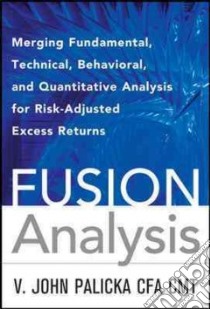- Libreria
- >
- Libri in lingua
- >
- Economia, finanza e management
- >
- Finanza e contabilità
Fusion Analysis - 9780071629386
Un libro in lingua di Palicka V. John edito da McGraw-Hill, 2011
- € 80.40
- Il prezzo è variabile in funzione del cambio della valuta d’origine
Learn the groundbreaking technique of “fusing” different investing styles together into one unified, powerful investment strategy
Because fundamental analysis alone is often an inadequate approach to assessing the strengths and weaknesses of an investment, investors and portfolio managers have begun to include the benefits of technical analysis into their investing programs. In Fusion Analysis, John Palicka introduces this complex but revolutionary new approach, showing you how to use a blend of fundamental, technical, behavioral, and quantitative disciplines to build one successful investment strategy.
Table of Contents
Chapter 1. Market return/risk characteristics within the context of the Efficient Market HypothesisChapter 2. CAPM assumptions and scenario analysis biases
Chapter 3. Major market valuation models will be compared to major technical models in terms of buy/sell points
Chapter 4. Value and Growth valuation theories
Chapter 5. Behavioral finance and psychological considerations
Chapter 6. Fama fundamental investment concepts
Chapter 7. Fed Model; T Rowe Price indicator for small-cap stocks
Chapter 8. The valuation models will be discussed with such technical concepts as Dow Theory, Head and Shoulders, moving averages, volume confirmations, MACD, money flows and sentiment
Chapter 9. Pairs Trading and Fusion
Chapter 10. Derivative strategies and spread trading
Chapter 11. Market Neutral strategies
Chapter 12. Trading with algorithms and behavioral issues
Chapter 13. Bottoms up stock picking valuation models
Chapter 14. Fundamental models of Gordon Growth, PEG, discounted cash flows and translations to traditional valuation techniques
Chapter 15. Bubble Theories
Chapter 16. Real Estate Applications For Lenders, Investors, Appraisers, Flippers, Owners
Chapter 17. Opportunistic trading with climaxes, SUE and event anticipations
Chapter 18. Currency and commodity speculation
Chapter 19. Events in fundamentals will be combined with opportunistic trades from technical inputs
Chapter 20. GAAP vs. non-GAAP vs. normalized non-GAAP
Chapter 21. Cash Flows: GAAP, Free, Economic, Fusion
Chapter 22. These inputs will include: technical trading signals - triangles, rectangles, bottoms/tops, climax, trend/speediness, gaps, retracements, saucers, MACD, Bollinger, stochastics & RSI
Chapter 23. Inter-market analysis in terms of hedges, spreads, derivatives
Chapter 24. Cycles and unique technical approaches, such as Elliott Wave, Point and Figure, Japanese Candlesticks
Chapter 25. Quant analysis with Artificial Intelligence and Behavioral issues
Chapter 26. Exotic screen considerations
Chapter 27. Future Trends: Surrogate Mothers and Surrogate Investing; Genetic Investing, Predictive Analytical Investing
Chapter 28. Creating various screening criteria that complement an investment objective Project #:539117, Fusion Analysis
Chapter 29. Determining and obtaining sources for screens
Chapter 30. Assigning appropriate factors and weights
Chapter 31. Trading techniques
Chapter 32. Generating a target list of stocks that can be bought or shorted
Chapter 33. Establishing price targets for short-term traders and longer-term investors
Chapter 34. Exploring arbitrage opportunities and some major hedge fund strategies
Chapter 35. Incorporating derivative strategies
Chapter 36. Workshop of exchanging investment ideas and approaches
Informazioni bibliografiche
- Titolo del Libro in lingua: Fusion Analysis
- Sottotitolo: Merging Fundamental Technical, Behavioral, And Quantitative Analysis For Risk-Adjusted Excess Returns
- Lingua: English
- Autore: Palicka V. John
- Editore: McGraw-Hill
- Collana: McGraw-Hill (Hardcover)
- Data di Pubblicazione: 16 Dicembre '11
- Genere: BUSINESS and ECONOMICS
- Argomenti : Investment analysis Portfolio management Investments
- Pagine: 460
- ISBN-10: 0071629386
- EAN-13: 9780071629386


